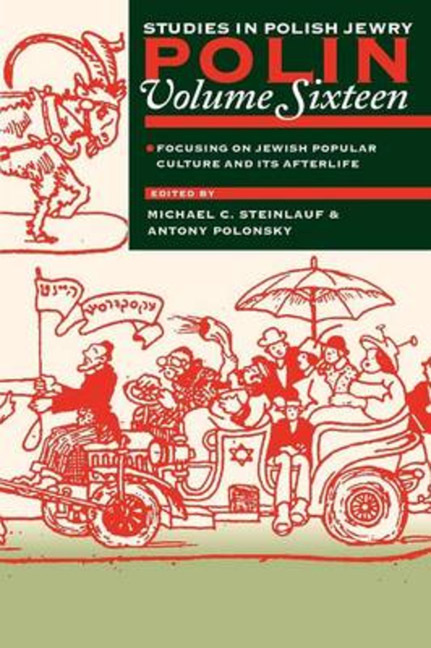Book contents
- Frontmatter
- Dedication
- Editors and Advisers
- Preface
- Polin
- Polin: Studies in Polish Jewry
- Contents
- Note on Place Names
- Note on Transliteration
- PART I JEWISH POPULAR CULTURE IN POLAND AND ITS AFTERLIFE
- IN PRE-WAR POLAND
- AFTERLIFE
- PART II DOCUMENTS
- A. Litvin: Chronicler of Jewish Souls
- Excerpts from Yidishe neshomes
- Urke Nachalnik: A Voice from the Underworld
- Excerpts from Życiorys własny przestępcy
- PART III NEW VIEWS
- PART IV REVIEWS
- REVIEW ESSAYS
- BOOK REVIEWS
- CORRESPONDENCE
- OBITUARIES
- Notes on the Contributors
- Glossary
- Index
Excerpts from Życiorys własny przestępcy
from PART II - DOCUMENTS
- Frontmatter
- Dedication
- Editors and Advisers
- Preface
- Polin
- Polin: Studies in Polish Jewry
- Contents
- Note on Place Names
- Note on Transliteration
- PART I JEWISH POPULAR CULTURE IN POLAND AND ITS AFTERLIFE
- IN PRE-WAR POLAND
- AFTERLIFE
- PART II DOCUMENTS
- A. Litvin: Chronicler of Jewish Souls
- Excerpts from Yidishe neshomes
- Urke Nachalnik: A Voice from the Underworld
- Excerpts from Życiorys własny przestępcy
- PART III NEW VIEWS
- PART IV REVIEWS
- REVIEW ESSAYS
- BOOK REVIEWS
- CORRESPONDENCE
- OBITUARIES
- Notes on the Contributors
- Glossary
- Index
Summary
Confessing evil requires more courage than committing it.
BEFORE I begin the sad story of my life I feel bound to give at least a summary of the circumstances that led me away from the straight and narrow. I ask the reader's forgiveness for first starting with a picture of my entrance into the world.
I see this as through a fog—a little town on the banks of the River Narew. A twostorey brick house lies in the centre of the town, almost on the market square. From the outside it is distinguishable only for having a porch with two benches at the entrance to a store. Above the entrance is the Russian sign ‘Flour Shop’, along with the woman proprietor's name, N.N.
The owner of the house is a tall man of 30, healthy-looking with soft, disarming eyes. These features are usually found in extraordinarily strong people. His wife is a woman of 25 with an intelligent look—a typical blonde. This rather well-matched couple belongs to the Jewish intelligentsia of this small town.
In my mind's eye I see this house on a beautiful day in June 1897. The store is closed because of the birth of the first-born son. Friends and relatives are congratulating my parents; I see great joy all around.
I see my mother lying in the bedroom, all in white with a triumphant maternal smile playing on her somewhat pale face. I lie on her right side, bundled in my blankets. My father stands in the centre of the room receiving congratulations. He's serious and thoughtful; his eyes shine with happiness.
I see people come and go from the house. On every face I see joy, both sincere and insincere.
More people gather in front of the house. They comment on the miracle of my birth. I hear snippets of conversation: ‘God showed His mercy and listened to them, giving them a son.’ Now I hear whispers: ‘The rich always have luck!’ The woman listening nods her head, and lifts her hands reverently, saying, ‘A real wonder, five years after the wedding, nu, nu.
- Type
- Chapter
- Information
- Focusing on Jewish Popular Culture and Its Afterlife , pp. 389 - 412Publisher: Liverpool University PressPrint publication year: 2003

